SURF FIT NEWS – No.4 by Clive Rodell
Core Training;
We have been looking at postural considerations to minimise injury risk and to make sure our foundations are solid.
Here’s the last piece of the puzzle before embarking on some training exercises.
Core training has become a buzz word over the past decade. Unfortunately it is largely misunderstood and the exercises given to ‘enhance the core’ are quite often misguided.
First of all let’s look at the dictionary explanation of the word ‘core’.
Pertinent to this article, the English Dictionary says;
A cylindrical sample of rock,
To the depths of one’s being
The part of something that is central to its existence or character.
The tough central part of various fruits
Now let’s examine those definitions;
A cylindrical sample of rock,
A great way to visualise ‘Core’.
To the depths of one’s being,
It’s not just on the outside, it’s completely from the outside through to the finest part of the centre.
The part of something that is central to its existence or character.
Your centre, your ability to centralize, your ability to locate inner function to exercise safely.
The tough central part of various fruits
The tough/functional/strong innermost foundation for the structure(s) surrounding it.
Now, at no point does it say anything about a strip, a bit part or any individual component.
So, I bet a lot of you have been told strengthen your Abdominals to strengthen your core or train the muscles in your lower back and you’ll get a strong core…
I used to teach exercise classes, up to a few years ago. In the 90s/2000s I would get the participants to follow me through various abdominal and lower back strengthening exercises. Personally I would do about 5000 crunches etc etc, per week. I had Abs of concrete or steel!
However, I still had lots of back pain and back issues manifesting periodically.
I used to interact and handle a lot of rehabilitation exercise, for the clients M.G.S. Physiotherapy in Manly. At that time I ran the Weight-room and training areas at the Harbord Diggers Gym (I designed most of the facility). The two great Physios in Manly, David Sheppard and Matt Geister, would also help with my back problems.
One day, Matt turned around and said to me (early 90s), “you know, I think part of your back issues are due to the fact your Abs are too strong”!
That one sentence changed my whole thinking from that point onwards. I started to view ‘Core’ so differently. I also embarked on a totally new way of training my clients. Which over the following years negated Ab work almost entirely (in the traditional sense).
With (in 99% of cases) absolutely no traditional Ab workouts, my clients have great core and …. really good Abs!
If there’s a Trainer that you are using and he says great Abs makes great Core….. He hasn’t got the knowledge to train you correctly! Just Sayin’! 🙂
So how do we train to get good ‘core’?
If we go back to the definitions and simplify them, let’s paint a picture that from your shoulders to your hips you are a baked bean tin. A baked bean tin, however, that does flex and move, but never leaks the tomato sauce!
That bean can is a cylinder, the cylinder is round.
ANY force, from any angle, applied against any portion of the 360 degrees will stress the can. The old adage…what doesn’t kill you makes you strong could be perceived here!
If the can withstands the force and does not lose it’s integrity it’s maintaining it’s fundamental (core) strength.
Stressing the can, will lead to the body understanding that it needs to perhaps bolster the can in certain areas. Hence the can responds and gets stronger.
Here’s a simple experiment;
stand upright and strong.
Get a friend to put his hand on the side of your shoulder area.
Get him to gently apply pressure, trying to push you sideways.
Resist that movement.
Get him to progressively push a little harder, you will have to ‘switch on’ more to resist the movement.
Feel what is happening internally.
As more pressure is applied, you will feel it more and more.
There will be a point that you cannot stay strong and resist, that’s your core succumbing to the force and is the core strength limit.
How do we do this in training terms?
Well firstly, just getting someone to push and pull you from different angles will promote core strength.
Over the last 12 years I started to develop a system of training that I call ‘C of G shift’. This is moving/exerting a load on the body that is shifting during the exercise.
If I weigh 85kgs and put a suit of armour on that weighs 10kgs, I exert a load of Body weight plus 10kgs. If I start to move and the leg armour weighs more than the limb (which it obviously does) I then have an extra load on my centre over and above my body weight, stressing the centre/core more then usual.
If I then wield a heavy sword and move around the load shifts constantly.
Add a movable medium under your body (a ball, roller or Bosu etc) then you increase the training stimulation again. All the time your core is working and adapting (training).
There is more to the C of G method than this, but those are the underlying principles.
Here are some advanced examples, pls be mindful of safety and the level you are currently at;
A sequential C of G movement might be;
A Bosu workout involving a Squat, Bicep Curl, Military Press and Pullover.
It could also be the one legged Bosu Row.
Please remember to download the Ask Clive App from ITunes or other platforms on the web. Use it to ask specific questions for you/your training and to also prompt my topics for articles on baliwaves.com
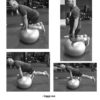
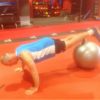
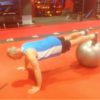
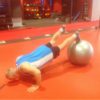

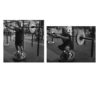
Recent Comments